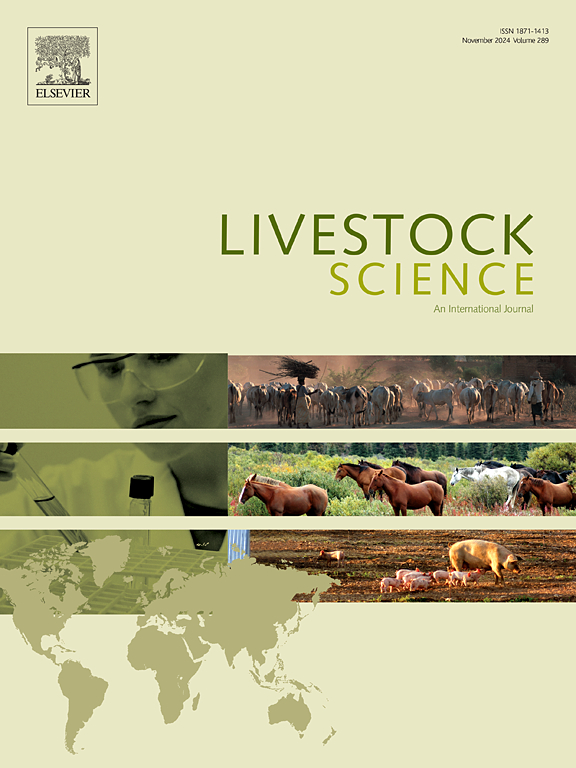Effect of inbreeding on reproductive, growth and morphological traits of Mertolenga cattle in Portugal
IF 1.9
3区 农林科学
Q2 AGRICULTURE, DAIRY & ANIMAL SCIENCE
引用次数: 0
Abstract
Inbreeding is a common issue in small breeds under conservation and larger breeds under selection, leading to genetic diversity loss, increased homozygosity, and inbreeding depression. This study estimated the effect of inbreeding (Fi) and inbreeding rate (ΔFi) on productive, reproductive and morphological traits and assessed the impact of including these parameters in the animal model used to estimate their genetic parameters. Genealogical and production data from the Mertolenga herdbook were analyzed using MTDFREML software and mixed models to estimate the effect of Fi and ΔFi on different traits and their genetic parameters. Inbreeding depression was evaluated through trait regressions on individual and maternal inbreeding coefficients, with genetic parameters estimated with and without inbreeding as a covariate. Significant negative effects (P < 0.01) of inbreeding were found for reproductive traits, weaning weight, and carcass weight per day. Among morphological traits, Fi affected only MT2 (P < 0.01), while ΔFi significantly impacted most traits (P < 0.01), except MT16 (P > 0.05). Inbreeding had an unfavorable effect on all the reproductive and growth traits analyzed. The largest differences in estimates of variance components and heritability between models with and without Fi were observed for productive longevity and total number of calvings. The results obtained suggest that ignoring inbreeding may lead to under- or overestimation of heritability and that the ΔFi can provide a more accurate assessment of the cumulative negative impact of inbreeding over time, particularly where there are some gaps in the pedigree. Livestock improvement programs should balance genetic progress and genetic diversity to mitigate inbreeding effects.
近交对葡萄牙Mertolenga牛繁殖、生长和形态性状的影响
近交是保护下的小品种和选择下的大品种的常见问题,导致遗传多样性丧失,纯合性增加和近交抑制。本研究估计了近交(Fi)和近交率(ΔFi)对生产、生殖和形态性状的影响,并评估了将这些参数纳入用于估计其遗传参数的动物模型的影响。利用MTDFREML软件和混合模型分析了Mertolenga遗传手册中的家谱和生产数据,估计了Fi和ΔFi对不同性状及其遗传参数的影响。通过个体和母系近交系数的性状回归来评估近交抑制,并以有无近交的遗传参数作为协变量进行估计。显著的负面影响(P <;繁殖性状、断奶重和日胴体重的近交系差异均为0.01)。在形态性状中,Fi仅影响MT2 (P <;0.01),而ΔFi显著影响了大部分性状(P <;0.01), MT16除外(P >;0.05)。近交对所分析的所有生殖和生长性状均有不利影响。在有和没有Fi的模型之间,对生产寿命和产犊总数的方差成分和遗传力的估计差异最大。所获得的结果表明,忽略近交可能导致对遗传力的低估或高估,ΔFi可以更准确地评估随时间推移近交的累积负面影响,特别是在谱系中存在一些差距的情况下。牲畜改良计划应平衡遗传进步和遗传多样性,以减轻近亲繁殖的影响。
本文章由计算机程序翻译,如有差异,请以英文原文为准。
求助全文
约1分钟内获得全文
求助全文
来源期刊

Livestock Science
农林科学-奶制品与动物科学
CiteScore
4.30
自引率
5.60%
发文量
237
审稿时长
3 months
期刊介绍:
Livestock Science promotes the sound development of the livestock sector by publishing original, peer-reviewed research and review articles covering all aspects of this broad field. The journal welcomes submissions on the avant-garde areas of animal genetics, breeding, growth, reproduction, nutrition, physiology, and behaviour in addition to genetic resources, welfare, ethics, health, management and production systems. The high-quality content of this journal reflects the truly international nature of this broad area of research.
 求助内容:
求助内容: 应助结果提醒方式:
应助结果提醒方式:


